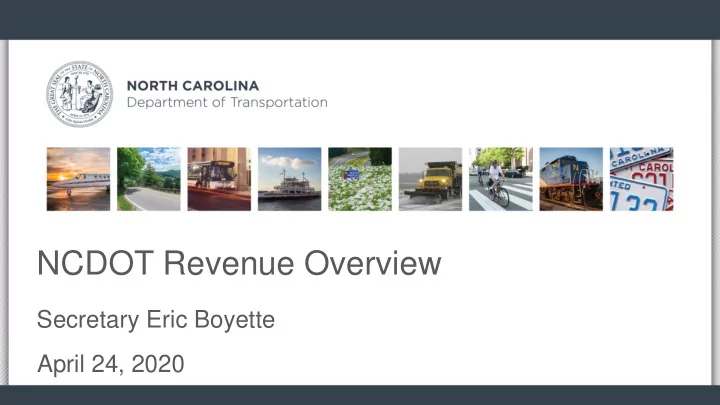

NCDOT Revenue Overview Secretary Eric Boyette April 24, 2020
• Current Situation COVID-19 • Impacts • Possible outcomes
Pre-COVID-19 • Storm response/recovery and legal settlements depleted cash balance, department enacted aggressive measures: - Delayed project lettings, reduced capital program - Decreased or suspended routine maintenance • NCDOT enacted a spend plan with targets below appropriated levels - Appropriations for restricted accounts increased, decreased General Maintenance Reserves (GMR) - NCDOT had to prepare for mandated move of funds into new disaster reserve 3
Deferred Maintenance 4
Deferred Maintenance 5
June 2019 Storm 6
February 2020 Storm 7
8
April 7, 2020 Storm 9
Current Situation • Pre-COVID-19, NCDOT operating on thin margin • Because NCDOT is 100% receipt supported, COVID-19 impact to traffic volumes is devastating - Volumes down by 40% - 50% - Impacts revenue by more than $300M in this FY • Even with cuts already made, obligations not being kept, NCDOT will soon hit cash floor 10
11
12
NCDOT Expenditures SFY 2020 as of March 31, 2020 5 Unaudited Financial Report
Location of Material Suppliers
Revenue Outlook – April 2020 Comparison to Previous Event The Great Recession (Dec/2007 to June/2009) 1 st Comparison Next 4 Total Recession Time Interval Quarter Quarters 12/07 to 6/2009 Fuel Consumption -1.8% -4.3% -4.9% Total Revenues -3.1% -7.3% -6.5% Recovery Time* 57 Months COVID-19 Impact (Mar/2020 to ????) Comparison Quarter SFY 2020 SFY 2021 COVID Impact (Apr – June/2020) Certified Budget ?? to ?? Fuel Consumption -38% to -42% -7% to -11% -2% to -6% ??? Total Revenues -32% to -36% -6% to -10% -7% to -11% ??? Recovery Time* ??? *Recovery Time to Pre-recession levels 15
Revenue Outlook – April 2020 State Revenues (Highway Fund and Highway Trust Fund) Comparison Quarter SFY 2020 SFY 2021 COVID Impact (Apr – June/2020) Certified Budget 2020 to 20?? Fuel Consumption -40% average -9% -4% Total Revenues -$300M -$370M STIP Revenues (Highway Trust Fund and Federal Aid) Comparison SFY 2020 to SFY 5-Year Previous Budget 2021 Total -$312M -$650M 16
Current Actions • Keep 620 active construction projects moving if possible - Suspension of these projects could cost $1.5M per day in claims • Delay contract advertisements over next 12 months - Delay approximately 250 projects estimated at $2.1B - Remaining projects estimated at $675M (all supported by bonds or grants) • Hiring Freeze • 50% cost reduction in temporary and contract employees • Planning for possible furloughs, Reduction In Force (RIF) 17
Actions Going Forward Immediately suspend: Significantly reduce: - Wildflower Program - Mowing along roadways and rest areas - Litter Sweep - Storm repairs - Engineering Training Program - Sign repairs - HBCU and Summer Internship Program - Patching pavement - Economic development grants and projects - Municipal support for traffic signal/signs/landscaping - Passenger ferry from Hatteras to Ocracoke - Traffic signal installation - State Park road maintenance - Spot safety projects - Reimbursement to schools for road improvements - Incident Management Assistant Program (IMAP) - Ferry and rail operations 18
Possible Future Scenario 1 NCDOT does not receive any revenue replacement • NCDOT hits the floor • All future lettings not supported by GARVEE, BUILD NC or Federal grants are suspended for a minimum of 12 months • Employee furloughs begin in May • Active projects continue until NCDOT expends all funds • Additional consultant and temporaries layoffs • Non-highway programs also limited to only life and safety activities • NCDOT cannot fund restricted accounts Once below the floor - NCDOT cannot enter into any contracts or modify existing contracts - If an LPA closes, we cannot open with different vendor 19
COVID-19 Scenario #1 20
Possible Future Scenario 2 NCDOT receives partial replacement revenue • NCDOT still cannot meet budget requirements • Operations reduced to meet spend plan - Funding for projects, operations, modes, decreased below NCGA appropriated levels • Maintenance of existing network delayed - Only critical safety needs met - System remains at current state of repair 21
Post COVID-19 Scenario #2a Staying within spend plan – reduce funding to restricted accounts 22
Post COVID-19 Scenario #2b Fund restricted accounts at appropriated level 23
Possible Future Scenario 3 NCDOT receives replacement funding for disasters/COVID-19 • All obligations in the budget are met • No furloughs/layoffs • Direct stimulus for private sector jobs in all 100 counties • Ability to prepare, respond and recover from storms 24
Post COVID-19 Scenario #3 Return to pre-Florence activity level 25
Economic Benefits of Transportation Investments Highways According to the ARTBA 2015 U.S. Transportation Construction Industry Profile: The design, construction and maintenance of transportation infrastructure in North Carolina: - 54,749 direct jobs, 55,153 indirect jobs - Earnings of $3.7 billion annually - This sector contributes an estimated $673.6 million in taxes - 2019 public and private construction/maintenance investment - $7.4 billion Public Transportation According to TREDIS (Transportation Economic Development Impact System), North Carolina’s transit systems provided $1.51 billion in statewide business output and supported more than 12,000 jobs resulting in $650 million in wages. 26
Economic Benefits of Transportation Investments Aviation According to ITRE, North Carolina’s public airports annually contribute $52 billion to the state’s economy, supporting 307,000 jobs that generate $12.6 billion in personal income and $2.2 billion in state and local tax revenues. Ferries According to ITRE, North Carolina’s Ferry System contributes $735.2 million to the state’s economy, supporting 5,860 jobs that generate $217.3 million in personal income and $32.5 million in state and local tax revenues. Rail According to the NCDOT Comprehensive State Rail Plan (2015), freight and passenger rail networks contribute $1.88 billion in direct economic impacts per year for North Carolina. Additionally, broader social impacts generate $311 million in emissions and safety impacts annually as a result of the truck and auto vehicle miles traveled (VMT) avoided due to the use of freight and passenger rail in the state. 27
Recommend
More recommend